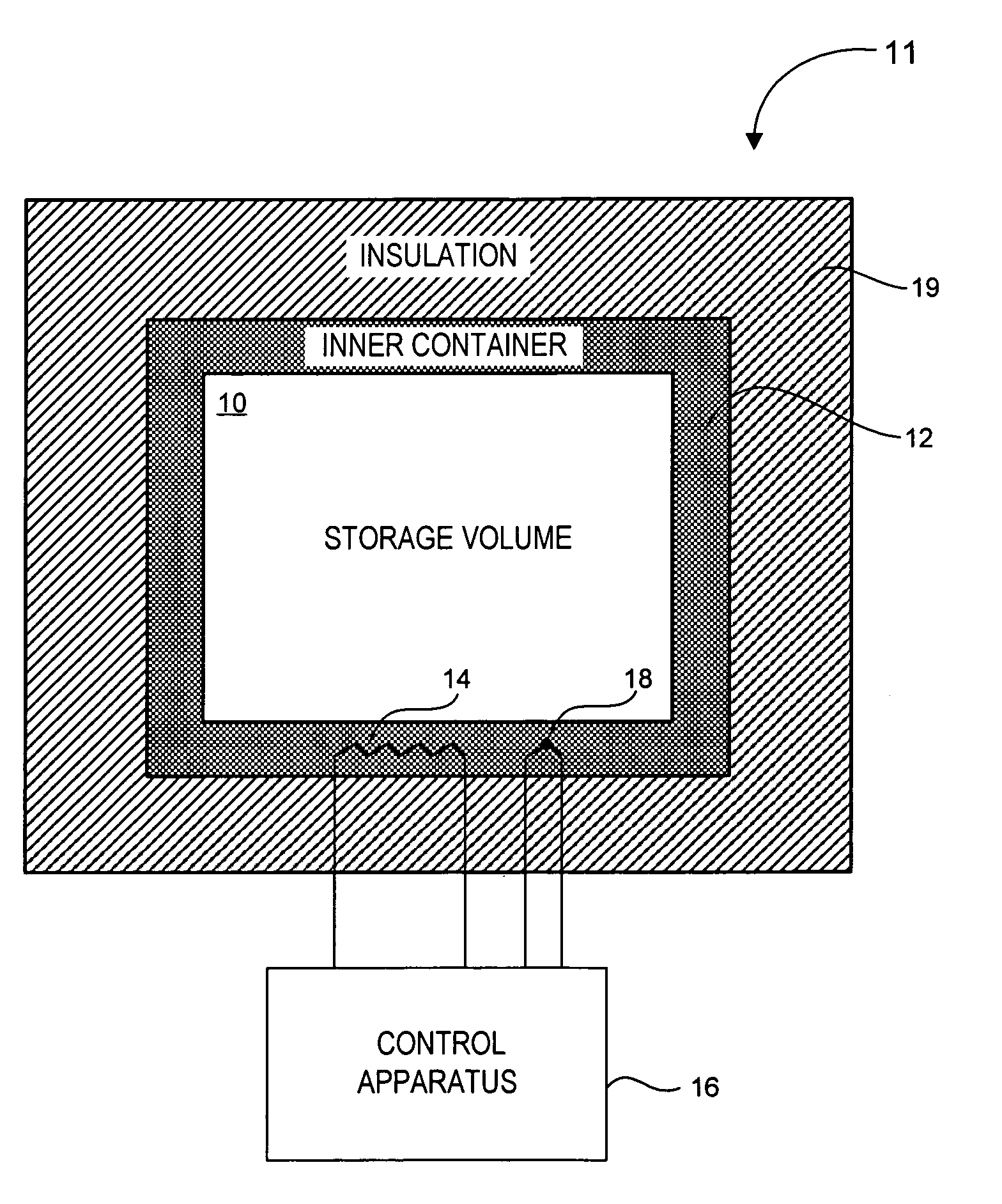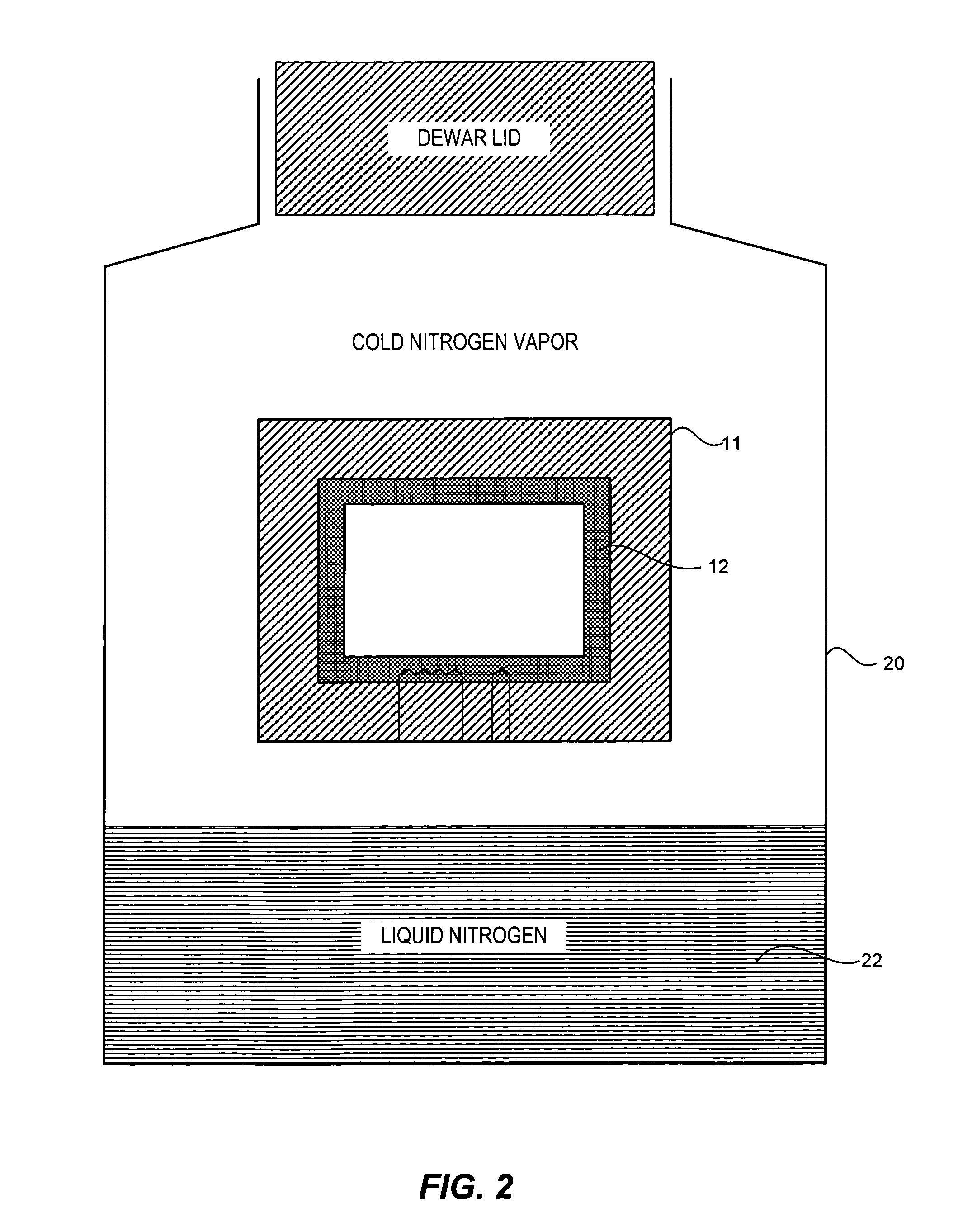Cryogenic storage system
a cryogenic storage and storage temperature technology, applied in the direction of domestic cooling apparatus, container discharge methods, lighting and heating apparatus, etc., can solve the problems of requiring the manipulation of storage temperature and the inability to bank large tissue masses, and achieve the effect of minimizing net heat flow, simple movement, and modest power requirements
- Summary
- Abstract
- Description
- Claims
- Application Information
AI Technical Summary
Benefits of technology
Problems solved by technology
Method used
Image
Examples
example 1
Manufacture of a Storage Container Device
[0062]A cylindrical aluminum container of 30 cm diameter, 30 cm height, and 3 mm thickness is obtained. The thermally conductive aluminum container has a temperature chamber within and is surrounded on all sides by a foam insulation of 5 cm thickness. The insulation has a thermal conductivity of 0.03 W / mK. The top portion of the container is formed as a lid to allow access to the temperature chamber inside. The container is placed inside a Dewar (as shown in FIG. 2) such that the bottom of the container rests on or near the surface of LN2 inside the Dewar. The bottom of the container is at a temperature of approximately −196° C. The temperature of the vapor in the Dewar is stratified such that the top of the container is at a temperature of −120° C. The target temperature for the temperature chamber is −150° C.
[0063]In another embodiment a Dewar similar to that shown in FIG. 11 is obtained having a diameter of 1 meter and an inner wall of 1 m...
example 2
Thermal Flow
[0064]The external surface area of the container of Example 1 is about 0.75 square meters. If the bottom half of this surface area is at −196° C., and the temperature chamber in the interior is at −150° C., the heat flow out of the container will be 11 watts, and the LN2 consumption will be about 5 liters per day or less. Similarly, if the top half of the container is at −120° C., the heat flow into this half will be approximately 7 watts. The difference between the 7 watt inflow and 11 watt outflow is made up by 5 watts of electric heat applied to the bottom of the thermally conductive container.
[0065]Seven watts travels from the top to the bottom of the aluminum thermally conductive container. The wall of the thermally conductive container has a cross sectional area of 0.003 square meters, and aluminum has a thermal conductivity of approximately 240 W / mK. The top-to-bottom temperature difference of the thermally conductive container is therefore only 3° C. despite the ...
example 3
Heat Sources and Heat Distribution
[0073]FIG. 13 depicts an example that is analogous to the setup described in Example 1, except that three large storage containers are placed in the Dewar instead of 25 smaller ones. Each storage container device is 2 meters long and has a temperature chamber defined by a 3 mm thick aluminum thermally conductive container. The containers have about 5 cm thick conventional foam insulation on all sides. The internal temperature is 135° C., and thermal contact with the central cold elements 1100 is arranged so that there is a 4 watt heat flow out of each storage container. System performance is 17 liters per day LN2 consumption.
[0074]In some embodiments multiple internal temperature sensing and heating points are used. In one embodiment a single resistive heater encircles the inner diameter of a container and supplies the requisite heating with only a 3° C. temperature variation within the container. In one embodiment independently controlled heaters a...
PUM
 Login to View More
Login to View More Abstract
Description
Claims
Application Information
 Login to View More
Login to View More - R&D
- Intellectual Property
- Life Sciences
- Materials
- Tech Scout
- Unparalleled Data Quality
- Higher Quality Content
- 60% Fewer Hallucinations
Browse by: Latest US Patents, China's latest patents, Technical Efficacy Thesaurus, Application Domain, Technology Topic, Popular Technical Reports.
© 2025 PatSnap. All rights reserved.Legal|Privacy policy|Modern Slavery Act Transparency Statement|Sitemap|About US| Contact US: help@patsnap.com



